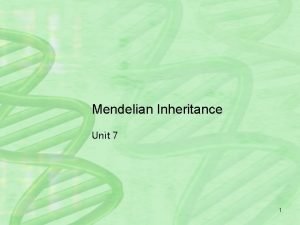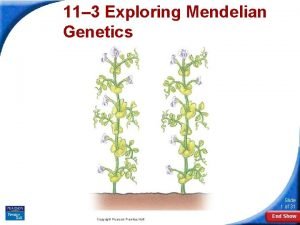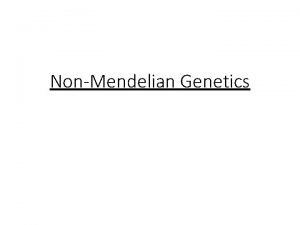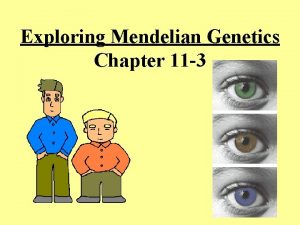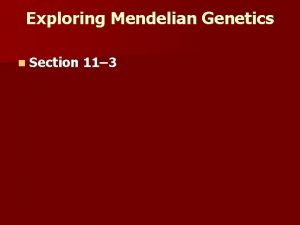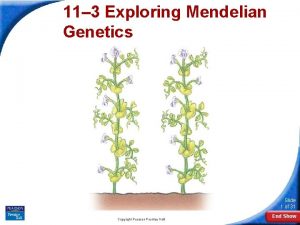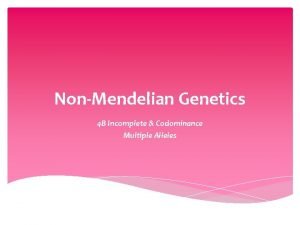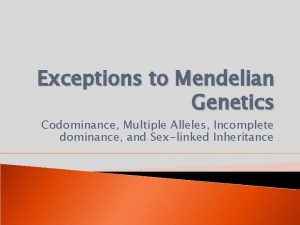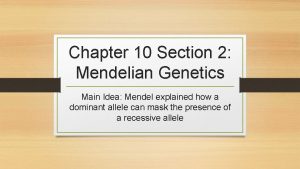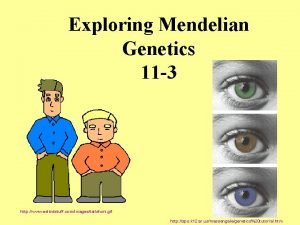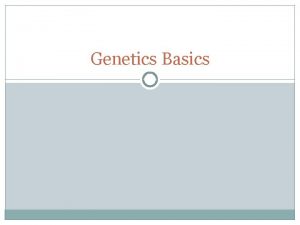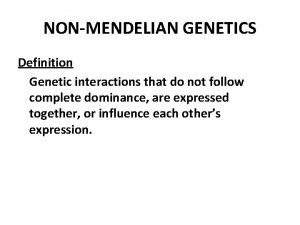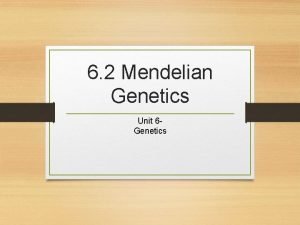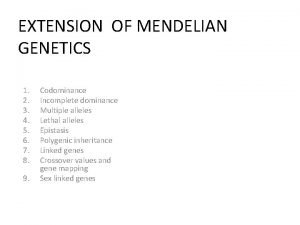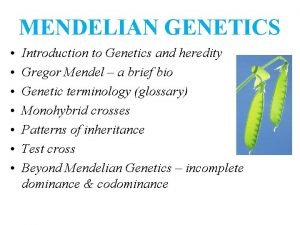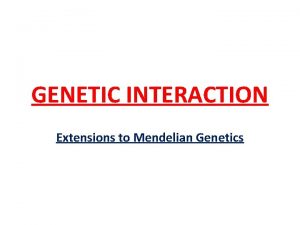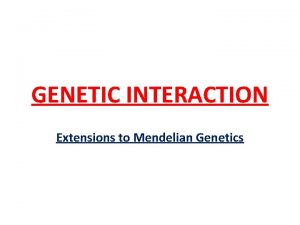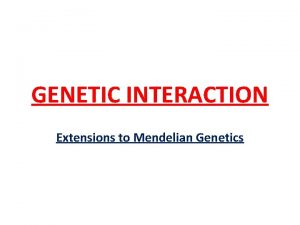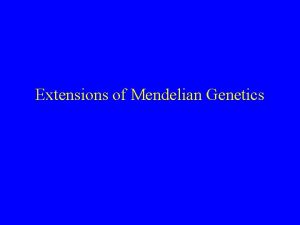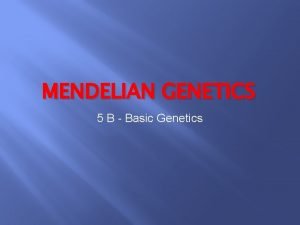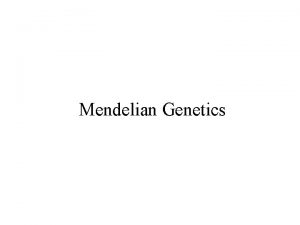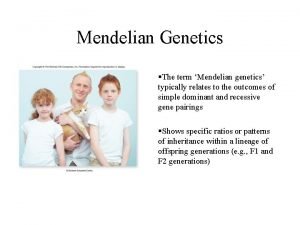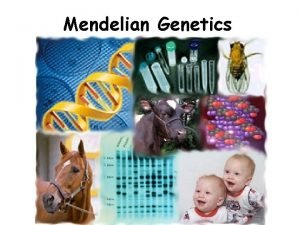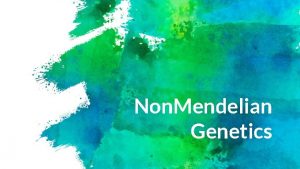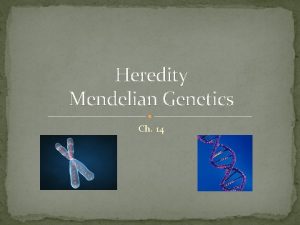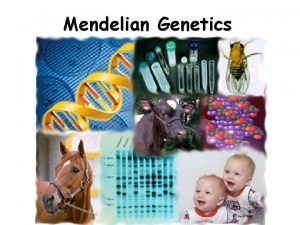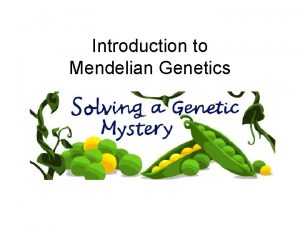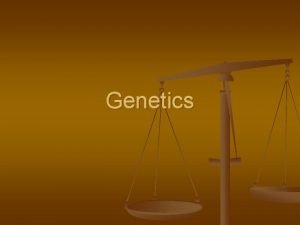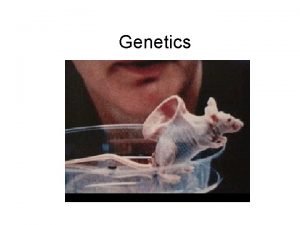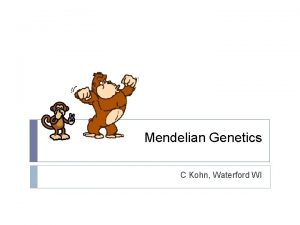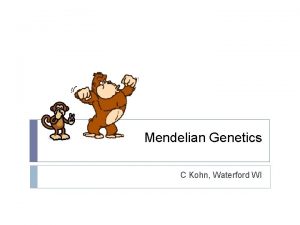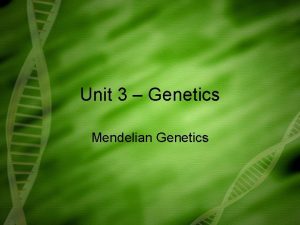GENETIC INTERACTION Extensions to Mendelian Genetics GENETIC INTERACTION


























- Slides: 26

GENETIC INTERACTION Extensions to Mendelian Genetics

GENETIC INTERACTION • With the help of different experiments, it was found that most of the characters of living organisms are controlled / influenced / governed by a collaboration of several different genes. • This condition where a single character is governed by two or more genes and every gene affect the expression of other genes involved (means these genes affect each other's expression) is known as gene/genetic interaction.

• In simple way we could say that, in gene interaction, expression of one gene depends on expression (presence or absence) of another gene. • As we know, gene interactions may involve two or more pairs of genes. • These interactions produce modified dihybrid ratios.

Gene Interaction Occurs When Genes at Multiple Loci Determine a Single Phenotype • Effects of genes at one locus depend on the presence of genes at other loci. • Gene interaction produces novel phenotypes.

Two Genes Can Interact to Determine One Trait • Novel phenotypes can emerge from the combined action of the alleles of two genes. • In epistasis, one gene’s alleles mask the effects of another gene’s alleles. • For some traits, homozygosity for a mutant allele at one of two or more genes produces the phenotype.

Gene Interaction

Multistep pathway for color production

Complementary Gene Action • Each genotypic class may not always dictate a unique phenotype. • A pair of genes can often work together to create a specific phenotype. • We call this complementary interaction. • With this type of interaction we see 2 different phenotypes. • Two or more genotypic classes may display an identical phenotype. • Example: Two lines of pure breeding white flowered pea plants falling into different genotypic classes: AAbb & aa. BB • The both must have a dominant allele in both genes to


TYPES OF GENE INTERACTION Gene interactions can be classified as: • Allelic gene interaction. • Non-allelic gene interaction.

Allelic gene interaction • Expression of character is produced by interaction between two or more genes. • These interactions can be 1. Inter-allelic 2. Intra-allelic

Inter-allelic • In certain cases, two pair of genes determine a same phenotype but assorted independently, produce new phenotypes by mutual interactions and the F 2 phenotypic ratio 9: 3: 3: 1 remains unaltered. • Two pair of genes which interact to affect size and shape of comb but are independently transmitted exist in chicken. • Fewer also occur with modification of normal F 2 ratio. • EXAMPLE: Epistasis

Intra-allelic • It involves the phenomenon of formation of lethal genes. • Alleles that cause an organism to die only when present in homozygous condition are called lethal alleles. • The gene involved is considered an essential gene.

• When Mendel's Laws were rediscovered, geneticists believed that mutations would only alter the appearance of a living organism. However, it was discovered that a mutant allele could cause death. When an essential gene is mutated, it can result in a lethal phenotype. If the mutation is caused by a dominant lethal allele, the heterozygote for the allele will show the lethal phenotype, the homozygote dominant is impossible. If the mutation is caused by a recessive lethal allele, the homozygote for the allele will have the lethal phenotype.

• Lethal genes were first discovered by Lucien Cuenot while studying the inheritance of coat color gene in mice. He expected a phenotype ratio from a heterozygote cross of 3 yellow: 1 white, but the observed ratio was 2: 1. By performing test crosses, he determined that all the yellow mice were heterozygote and that the yellow color coat was the dominant phenotypic trait. However, no homozygous yellow mice were obtained. • In 1910, William Ernest Castle and C. Little reaffirmed Cuenot's discovery of a lethal gene by proving that a quarter of the offspring from crosses between heterozygote died during embryonic development. The quarter that died were the homozygous yellow mice that Cuenot did not see in his tests.

• An example of lethal alleles in humans is achondroplasia, a genetic condition which causes dwarfism. Affected individuals are all heterozygote, as the accumulation of two mutant alleles is lethal and results in stillbirths.


Allelic gene interaction • Expression of character is produced by interaction between alleles of a single gene. • Complete dominance • Incomplete dominance • Co-dominance • Over Dominance

Complete Dominance • A kind of dominance in which the dominant gene completely masks the effect of the recessive gene in heterozygous condition. • EXAMPLE: A simple monohybrid cross. •

Incomplete Dominance • In Incomplete Dominance, every genotype has its own phenotype. (One allele not completely dominant over the other. ) Third phenotype that is a blending of the parental traits. (2 alleles produce 3 phenotypes. ) – Result: Heterozygous phenotype somewhere in between homozygous phenotype.


Co-Dominance • Both dominant and recessive alleles are expressed equally in heterozygous • The resultant phenotype is the mixture of both the parents.

Chickens: Feather Color Black: B White: b

Black and White: Bb

Over Dominance • Over dominance is a condition in genetics where the phenotype of the heterozygote lies outside of the phenotypical range of both homozygote parents. Over dominance can also be described as heterozygote advantage, wherein heterozygous individuals have a higher fitness than homozygous individuals. • An example in humans is sickle cell anemia.

 Family resemblance test
Family resemblance test Section 11-3 exploring mendelian genetics answers
Section 11-3 exploring mendelian genetics answers Mendelian genetics vocab
Mendelian genetics vocab Multiple alleles
Multiple alleles Section 11-3 exploring mendelian genetics answer key
Section 11-3 exploring mendelian genetics answer key Chapter 7 extending mendelian genetics vocabulary practice
Chapter 7 extending mendelian genetics vocabulary practice Section 11-3 exploring mendelian genetics
Section 11-3 exploring mendelian genetics Mendel experiments in plant hybridization
Mendel experiments in plant hybridization 11-3 exploring mendelian genetics answers
11-3 exploring mendelian genetics answers Codominance and incomplete dominance
Codominance and incomplete dominance Section 11-5 linkage and gene maps answer key
Section 11-5 linkage and gene maps answer key Exceptions to mendelian genetics
Exceptions to mendelian genetics Chapter 10 section 2 mendelian genetics
Chapter 10 section 2 mendelian genetics Eslkidstuff
Eslkidstuff Mendelian genetics
Mendelian genetics Extending mendelian genetics answer key
Extending mendelian genetics answer key X linked recessive punnett square
X linked recessive punnett square Heterozygous b blood type
Heterozygous b blood type Describe incomplete dominance
Describe incomplete dominance Section 1 chromosomes and phenotype study guide a
Section 1 chromosomes and phenotype study guide a Mendelian genetics punnett square
Mendelian genetics punnett square Purebred vs hybrid
Purebred vs hybrid Pprr x pprr punnett square
Pprr x pprr punnett square Heredity concept map
Heredity concept map Chapter 7 extending mendelian genetics study guide answers
Chapter 7 extending mendelian genetics study guide answers Mendelian genetics
Mendelian genetics Chapter 12 section 1 dna the genetic material
Chapter 12 section 1 dna the genetic material
